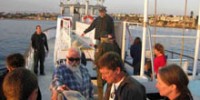By Kimmy Helling
We were treated to a close view of two gray whales expelling their massive breaths of air in the afternoon sunlight
As we motored out of Newport Harbor aboard the Western Pride fishing vessel, we were treated to a close up view of two gray whales expelling their massive breaths of air in the late afternoon sunlight, on their migration to Baja California. I was among the first participants in the Citizen Science Cruise, a new educational outreach program focused on marine protected areas.
 |
| Todd Lewis, superintendent of Crystal Cove State Park, and a local student monitor activity below sea level using FishTV. |
The program came from an unusual partnership between the Crystal Cove Alliance (CCA), a historical conservation group, and Newport Landing Sportfishing, a recreational fishing operation.
Such groups were often at odds through the debate leading to the establishment of new MPAs on January 1, but CCA President, Harry Helling provides perspective on what may become an increasingly common arrangement. “This is a viable economic alternative to keep fishing boats on the water without over-consuming local fish species.”
The educational cruises are conducted in the Newport Coast Marine Conservation Area, and are meant to raise public awareness of marine protected areas through observational science.
“Students will understand how scientists collect data, why it is important to collect data, and what scientists can learn from data that is collected,” said Sue Magdziarz, CCA Education and Public Programs Coordinator.
A pod of nearly a hundred common dolphins surfacing near our boat highlighted the amount of life that depends on MPAs, and the research students and scientists do to establish them. Participants in future cruises will gather data on behalf of Orange Coast College’s Coastal Dolphin Survey Project.
Among the participants were Orange County middle and high school teachers, a marine biologist from MBC Applied Environmental, a marine chemist, officials from California State Parks, students from Laguna Beach, and operators of recreational fishing boats.
The Western Pride has four stations with specialized equipment, my favorite of which featured a digital fishing rod that ‘catches’ underwater images. With a piece of fresh squid attached to attract sea life, the underwater camera allows students on deck to monitor fish activity in kelp forests below them.
 |
| Winter Bonnin, Crystal Cove State Park Interpretive Naturalist, enthusiastically baits the digital fishing rod with squid. |
FishTV is a similar device used to study marine life by dropping a fish shaped camera into the water and viewing activity on the monitor.
The Van Dorn bottle, an oceanographic sampling device, is attached to a deep-sea shark fishing rod, allowing students to collect seawater samples and compare water quality from different depths.
Volunteer Tim Arehart of Villa Park used a video-microscope to analyze the contents of a plankton net that was dragged behind the boat, looking for fish eggs and larvae that can signal fish population changes.
“Who can resist the treasure-hunt-in-a-petri-dish that comes from a plankton tow, or fishing with a camera? Do that for a living? Why not?” Arehart said.
Students on these cruises will conduct real science with real-world impact; their data will be used by California State Park officials to refine ocean management policies well into the future. Public involvement in ocean conservation is vital to the success of the MPAs, because these students may become the next generation of scientists and conservationists working to secure their longevity.
Todd Lewis, superintendent of Crystal Cove State Park, said, “This is an incredible example of the productivity possible when groups work together to achieve a worthy goal. I hope that students will take advantage of this unique opportunity to better appreciate the incredible world they live in.”
Over the next few months, new equipment will be purchased, research procedures will be refined, and teachers from last week’s cruise will develop a curriculum that can be used to integrate marine protected area studies into classrooms.

Tim Arehart, center, examines a plankton net that was pulled behind the boat.
Crystal Cove State Park Interpreter, Jennifer Langer, shared her high hopes, “A program like this can help create future stewards that understand the importance of protecting our ocean’s fragile ecosystems.”
In April and May, an estimated 500 students from middle and high schools throughout Orange County will be the first to participate in the program. The results from those student cruises will be used to create a new student agenda for marine conservation, effective in the 2012-13 school year.

Fish eggs and larvae caught in the plankton net are analyzed with a video-microscope in the boat’s onboard lab.
Trips are subsidized by grants from AT&T, Wells Fargo, Ueberroth Family Foundation, Southern California Edison, and Pacific Life Foundations as part of the Crystal Cove Alliance’s SNAP! (Science and Nature at the Park) program.

Sue Magdziarz, CCA Education and Public Programs Coordinator welcoming participants aboard the Western Pride.






